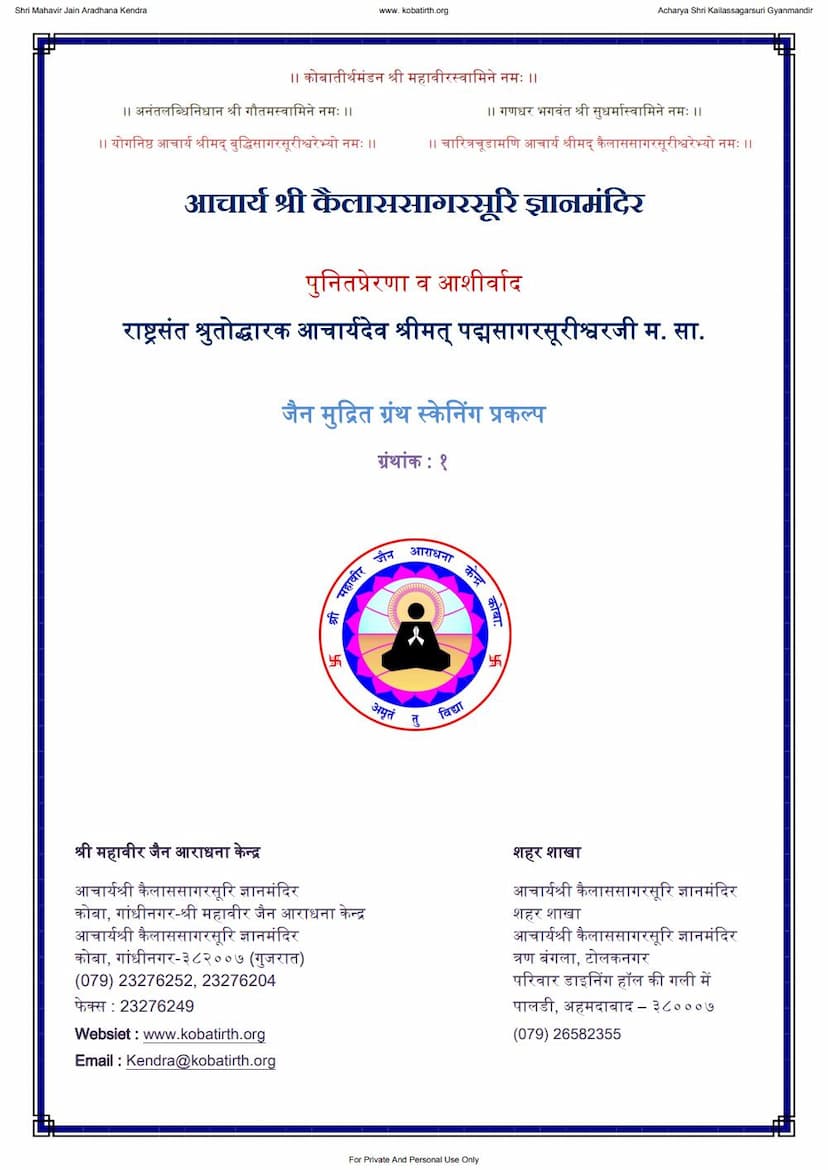Rajvidya
Added to library: September 2, 2025

Summary
This is a comprehensive summary of the Jain text "Rajvidya" authored by Balbramhachari Yogiraj, as extracted from the provided Jainqq.org link.
Book Title: Rajvidya Author: Balbramhachari Yogiraj Publisher: Balbramhachari Yogiraj Catalog Link: https://jainqq.org/explore/020594/1
Overall Theme:
"Rajvidya" is a treatise on the science of governance and kingship, presented as an ancient and lost knowledge that has been rediscovered. The text emphasizes the importance of righteous rule, the qualities of a good ruler, the welfare of the populace, and the interconnectedness of spiritual and temporal power. It draws heavily on Hindu scriptures like the Bhagavad Gita and aligns with Jain principles of righteousness, non-violence, and ethical conduct.
Key Concepts and Content:
- The Lost Art of Kingship: The book posits that "Rajvidya," the science of ruling, was once paramount in India but became lost for thousands of years, as indicated in scriptures. It highlights the efforts to bring this knowledge back to light.
- The Ideal Ruler: The text extensively describes the attributes and responsibilities of an ideal king. This includes:
- Righteousness and Dharma: The king must uphold dharma (righteousness, duty) in all aspects of governance. This encompasses justice, compassion, and adherence to ethical principles.
- Wisdom and Knowledge: A ruler must possess profound knowledge, understand the nuances of governance, and be able to discern truth from falsehood.
- Strength and Courage: While emphasizing dharma, the king must also be strong, courageous, and capable of defending his kingdom and people. This includes mastery of arms and strategic warfare.
- Self-Discipline and Control: The king must exercise control over his senses, desires, and emotions (like Kama, Krodha, Lobha, Moha, Ahankara).
- Welfare of the People (Prajavatsalya): The king's primary duty is the welfare, happiness, and prosperity of his subjects. This includes ensuring justice, providing for the needy, and promoting education and well-being.
- Service and Responsibility: The king is seen as a servant of the people and a steward of the kingdom, entrusted with its care.
- The Importance of Knowledge and Understanding: "Knowledge is Power" (as alluded to in English proverbs) is a recurring theme. The ability to understand situations, people, and the natural order is crucial for effective rule.
- The Role of Kshatriyas: The text places significant emphasis on the Kshatriya (warrior/ruling) class, tracing its lineage from ancient kings like Manu and Ikshvaku. It suggests that the essence of Rajvidya is deeply ingrained in the Kshatriya bloodline.
- The Pillars of Governance: The book details various aspects of governance, including:
- Justice System: Emphasis on fair and impartial judgment, with different types of justice and procedures.
- Economic Management: Principles of income and expenditure, taxation, and resource management.
- Military and Defense: The importance of a strong and disciplined army, strategic positioning, and knowledge of warfare.
- Social Welfare: Provisions for the poor, sick, orphaned, and widowed.
- Education and Culture: Promotion of various arts and sciences, religious teachings, and adherence to ancient traditions.
- Diplomacy and Foreign Relations: Understanding neighboring kingdoms, employing spies, and maintaining strategic relationships.
- The Divine Connection: The text often refers to divine powers and principles, suggesting that righteous rule is aligned with cosmic order and divine will. The king's actions are seen as a reflection of higher spiritual forces.
- The Structure of the State: Various administrative roles and hierarchies are discussed, from the emperor down to local administrators. The text uses metaphors like the human body to explain the interconnectedness of these roles.
- The Significance of Symbols and Rituals: While not extensively detailed in the provided pages, the presence of diagrams and the mention of various symbols (like the Trishul) suggest a ritualistic or symbolic dimension to the governance described.
- The Influence of the Bhagavad Gita: The text frequently quotes or alludes to verses from the Bhagavad Gita, particularly regarding the nature of duty, righteousness, and the divine.
Key Figures and Contributors:
- Balbramhachari Yogiraj: The author, who rediscovered and presented this ancient knowledge.
- Acharya Shri Kailassagarsuri: Mentioned in the introductory pages, indicating a lineage of spiritual guidance.
- Maharaja Shri Umaid Singhji Sahib Bahadur: A prominent figure, likely a ruler of Marwar (Jodhpur), to whom the book is dedicated, signifying royal patronage and support.
- Rao Raja Shri Gulab Singhji Sahib: Mentioned as a significant contributor and supporter in the printing and propagation of the book, highlighting his generosity and commitment to the cause.
Overall Purpose and Message:
"Rajvidya" aims to revive and disseminate the ancient Indian science of governance, emphasizing that true kingship is not merely about power but about righteous duty, selfless service, and the holistic welfare of the kingdom and its people. It serves as a guide for rulers and administrators, offering principles for establishing and maintaining a just, prosperous, and spiritually aligned society.
This summary is based on the content visible in the provided PDF pages, which includes the title, author, publisher, dedications, introductory remarks, table of contents, and substantial portions of the text itself.